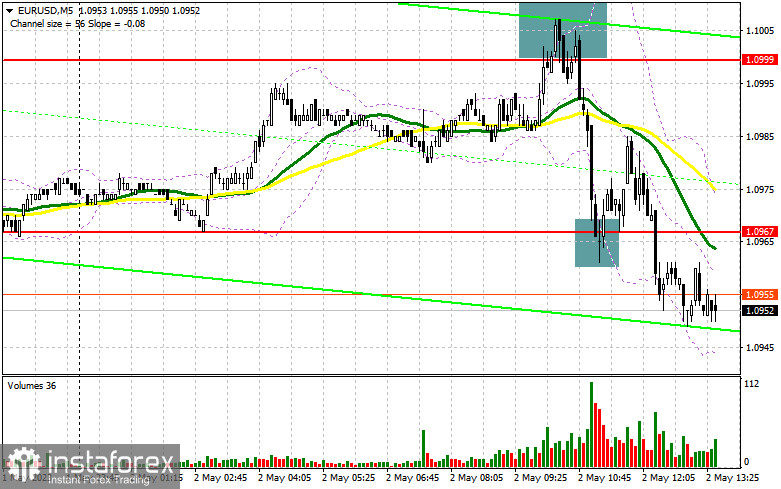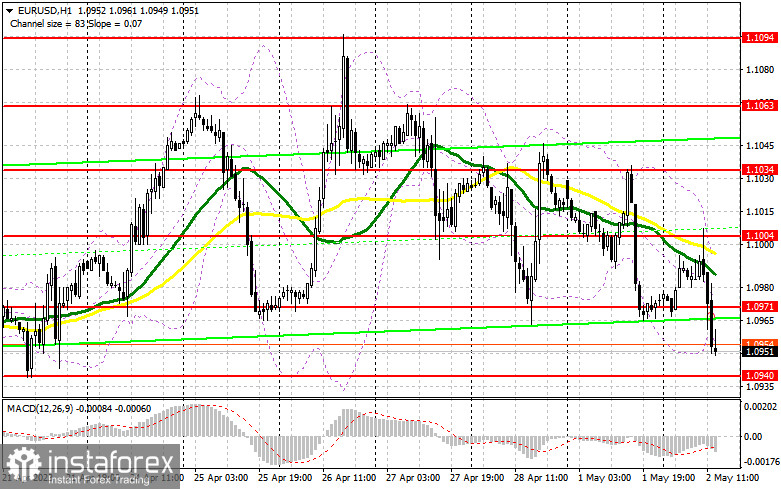In my morning forecast, I focused on the 1.0999 level and recommended making market entry decisions from there. Let's look at the 5-minute chart and see what happened there. The growth and formation of a false breakout allowed for an excellent entry point for short positions, leading to the pair's sell-off by more than 30 points. Active buyer protection at 1.0967 and a false breakout there led to an entry point for long positions, but after moving up 16 points, buyer activity dropped sharply.

To open long positions on EURUSD, it is necessary:
Inflation data in the eurozone fully coincided with economists' forecasts, not allowing for a clear determination of how much the European Central Bank will raise rates this week. Since core prices have even decreased from their peak, pressure on the euro returned in the first half of the day. For the American session, data on changes in the volume of manufacturing orders will further help the dollar, and figures on vacancy levels and labor turnover from the US Bureau of Labor Statistics are planned.
For this reason, I will not rush to buy euros. I will wait for a further decline and a false breakout around 1.0940, which will signal a purchase with growth to a new resistance level of 1.1004, formed from the first half of the day. Moving averages also pass, playing on the bears' side. A breakthrough and a top-down test of this range will strengthen buyers' confidence, bringing the pair back within the lateral channel and forming an additional entry point for increasing long positions with a renewal of 1.1034. The ultimate target remains the 1.1063 area, where I will again lock in profits.
In the scenario of a decline in EUR/USD and the absence of buyers at 1.0940 in the second half of the day, and everything is heading in this direction, pressure on the pair will increase at the beginning of this month. Only the formation of a false breakout in the area of the next support level of 1.0911 will provide a signal to buy euros. I will open long positions immediately on a rebound from the minimum of 1.0867, with a target of an upward correction of 30–35 points within the day.
To open short positions on EURUSD, the following is required:
Sellers have done everything necessary to continue the downward correction, and an important task for the second half of the day is to protect the new resistance level of 1.0971. The reaction to US data, which may be even better than economists' forecasts, and a false breakout at this level, is another sell signal capable of pushing the pair to 1.0940. Consolidation below this range and a reverse test from bottom to top is a direct path to 1.0911. The farthest target is the minimum of 1.0867, where profits will be fixed.
In the event of an upward movement in EUR/USD during the American session and the absence of bears at 1.0971, which cannot be ruled out given the upcoming FOMC meeting this week and the market balance is maintained, I will most likely postpone short positions until the 1.1004 level, where bears have already shown themselves once. It is also possible to sell there, but only after unsuccessful consolidation. I will open short positions immediately on a rebound from the maximum of 1.1034 with a target of a downward correction of 30–35 points.


Indicator signals:
Moving averages
Trading is taking place below the 30- and 50-day moving averages, indicating an attempt at control by sellers.
Note: The author considers the period and prices of moving averages on the hourly chart H1 and differ from the general definition of classical daily moving averages on the daily chart D1.
Bollinger Bands
In the case of growth, the upper boundary of the indicator at around 1.1000 will act as resistance.
Indicator descriptions
• Moving average (defines the current trend by smoothing volatility and noise). Period 50. Marked in yellow on the chart.
• Moving average (defines the current trend by smoothing volatility and noise). Period 30. Marked in green on the chart.
• MACD indicator (Moving Average Convergence/Divergence - convergence/divergence of moving averages) Fast EMA period 12. Slow EMA period 26. SMA period 9
• Bollinger Bands (Bollinger Bands). Period 20
• Non-commercial traders - speculators such as individual traders, hedge funds, and large institutions using the futures market for speculative purposes and meeting certain requirements.
• Non-commercial long positions represent the total long open position of non-commercial traders.
• Non-commercial short positions represent the total short open position of non-commercial traders.
• The total non-commercial net position is the difference between the short and long positions of non-commercial traders.
 English
English 
 Русский
Русский Bahasa Indonesia
Bahasa Indonesia Bahasa Malay
Bahasa Malay ไทย
ไทย Español
Español Deutsch
Deutsch Български
Български Français
Français Tiếng Việt
Tiếng Việt 中文
中文 বাংলা
বাংলা हिन्दी
हिन्दी Čeština
Čeština Українська
Українська Română
Română

